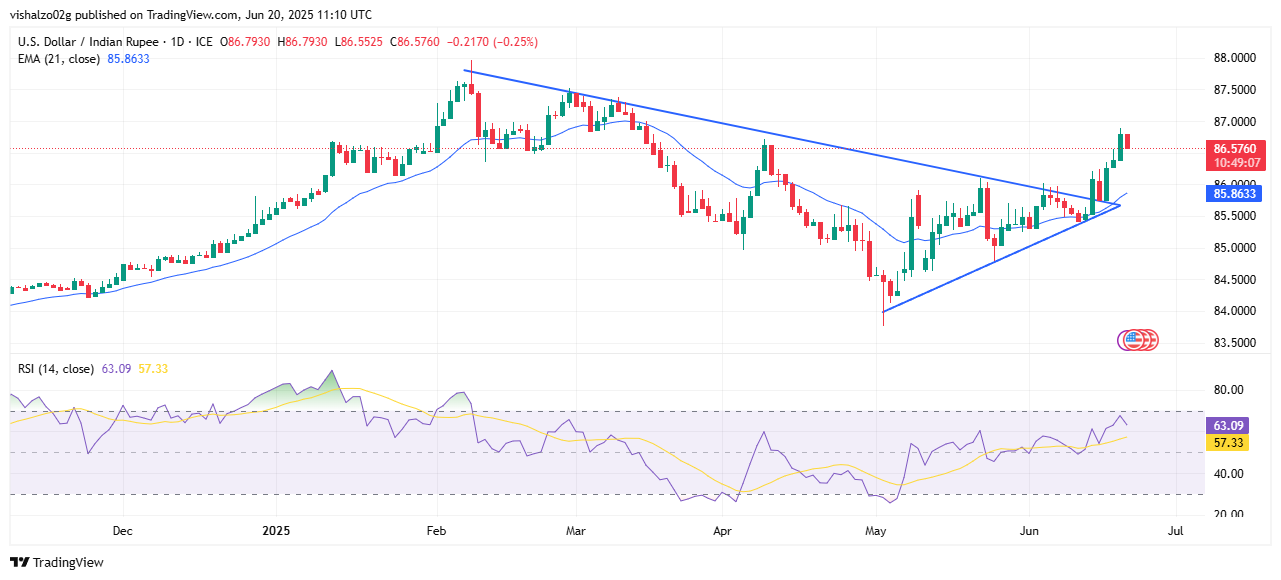
- INR recovers slightly on Friday, lifted by gains in domestic Stocks and a softer US Dollar.
- Brent Crude Oil trims recent gains but holds a weekly rise of over 4% so far as Middle East tensions persist.
- Equity benchmarks Sensex and Nifty rally over 1% each, snapping a three-day losing streak.
The Indian Rupee (INR) snaps its three-day losing run against the US Dollar (USD) on Friday, recovering modestly after hitting a three-month low the previous day. A softer Greenback and a pullback in Crude Oil prices lent support to the Rupee, as traders digest US President Donald Trump’s two-week delay to decide if the US will step into the Israel–Iran air conflict.
USD/INR is drifting lower during the American trading hours, last seen trading around 86.60 at the time of writing. The pair has eased from its multi-month high but remains up over 0.50% for the week, underpinned by elevated Crude Oil prices amid the ongoing Iran–Israel conflict.
While Trump’s two-week window to decide about Iran has temporarily calmed fears of an immediate escalation, risk appetite stays fragile as the conflict entered its eighth day on Friday with continued missile strikes and no clear path to de-escalation. Investors remain cautious that any miscalculation could disrupt energy flows and weigh further on emerging market currencies like the Rupee, particularly if Crude Oil prices reverse course and climb higher again.
Market Movers: Oil, Equities, Geopolitics shape Rupee moves
- The Indian Rupee edged higher on Friday, aided by strength in domestic equity markets, which helped lift sentiment. A relatively steady trend in global Crude Oil prices also provided some relief to the energy-import-reliant currency.
- Fresh domestic data is reinforcing India’s growth outlook. A new report from Motilal Oswal Private Wealth (MOPW) on Friday noted that the economy is benefiting from multiple supportive trends: GDP growth accelerated to 7.4% in Q4 FY25 — the strongest in a year — while inflation has stayed below 4% for four straight months, and GST revenues continue to rise steadily. These factors point to robust demand and stable formal-sector activity, helping underpin market sentiment for the Rupee.
- India’s benchmark equity indices bounced back sharply on Friday after three days of losses, boosting overall market sentiment. The 30-share BSE Sensex jumped 1,046.30 points, or 1.29%, to close at 82,408.17, while the NSE Nifty50 rose 319.15 points, or 1.29%, to finish at 25,112.40.
- Brent Crude has slipped over 2% so far on Friday, easing near $77 per barrel as traders reacted to signs that the US may hold off immediate military action in the Israel–Iran conflict. Despite the dip, prices are still set for a weekly gain near 4%, keeping energy markets sensitive to any fresh escalation that could disrupt supply routes.
- The Reserve Bank of India (RBI) released the minutes from its June 4–6 Monetary Policy Committee meeting on Friday. The June meeting saw the RBI cut the repo rate by 50 bps to 5.5 percent, marking the second back-to-back cut since February.
- RBI Governor Sanjay Malhotra said that the central bank’s cumulative 100 basis points cut in the repo rate and a matching 100 bps reduction in the Cash Reserve Ratio (CRR) since February will help anchor stability amid global volatility and support India’s growth momentum in the near term. “This package of measures will provide some certainty in the times of uncertainty and is expected to support growth,” highlighting that the combined 100 bps cuts in both the repo rate and CRR since February aim to bolster India’s resilience amid global market swings.
- Investor nerves remain heightened as the Iran–Israel war entered its eighth day, officials on all sides continue to trade sharp warnings. US President Trump reiterated on Thursday that he would “make a decision in the next two weeks” but stressed he still believes “there is room for diplomacy” with Tehran. Israel’s Prime Minister Benjamin Netanyahu declared that his country “will act alone if necessary,” signalling readiness to strike Iran’s Fordow nuclear site without US assistance. Meanwhile, a senior Iranian lawmaker warned that closing the Strait of Hormuz is “a real option” if Washington escalates, calling US military involvement a clear “red line” for Tehran.
- Anil Kumar Bhansali, Head of Treasury and Executive Director at Finrex Treasury Advisors LLP, told PTI, “The uncertainty over the Iran–Israel conflict persists, and US President Donald Trump has merely postponed America’s entry into the war by two weeks. The Rupee is expected to trade in the 86.35–86.95 range. Exporters are in a good position to sell dollars now, as the Rupee could appreciate to 85.50–85.75 levels in July if hostilities ease.”
- The US Dollar Index (DXY), which measures the Greenback’s value against a basket of six major currencies, edges lower on Friday, slipping back below the 99.00 mark. The index has eased from its weekly high touched on Thursday, and was last seen trading near 98.75 as traders reassess safe-haven demand.
- The Philadelphia Fed Manufacturing Index held steady at -4.0 in June 2025, unchanged from May and missing market expectations of a milder decline to -1. The reading highlights that manufacturing activity in the region remains sluggish, hindered by softening demand and cooling labor market conditions. Firms surveyed reported weaker new orders and a modest drop in employment, adding to evidence that the sector is losing momentum amid elevated borrowing costs and lingering economic uncertainty. Earlier this week, the central bank kept its benchmark rate unchanged at 4.25%–4.50% during its July meeting, as officials weigh sticky inflation against signs of slowing growth.
Technical Analysis: Bulls pause after multi-month high, key support at 86.00 in focus

USD/INR is showing early signs of a potential pause after a decisive breakout from a multi-month symmetrical triangle. Friday’s price action is forming a bearish daily candle, highlighting that the pair is struggling to hold gains after testing the psychological 87.00 barrier.
The breakout above the triangle resistance and the 21-day Exponential Moving Average (EMA), which now sits around 85.86, confirmed a shift in near-term sentiment from neutral to bullish earlier this week. However, the pair’s failure to close firmly above 87.00 has attracted profit-taking, raising the risk of a short-term pullback.
The Relative Strength Index (RSI) has cooled slightly from near overbought territory but remains comfortably above the neutral 50 level, suggesting that buyers still have control as long as the pair stays above the former triangle resistance, now acting as a support zone around 85.80–86.00.
RBI FAQs
The role of the Reserve Bank of India (RBI), in its own words, is “..to maintain price stability while keeping in mind the objective of growth.” This involves maintaining the inflation rate at a stable 4% level primarily using the tool of interest rates. The RBI also maintains the exchange rate at a level that will not cause excess volatility and problems for exporters and importers, since India’s economy is heavily reliant on foreign trade, especially Oil.
The RBI formally meets at six bi-monthly meetings a year to discuss its monetary policy and, if necessary, adjust interest rates. When inflation is too high (above its 4% target), the RBI will normally raise interest rates to deter borrowing and spending, which can support the Rupee (INR). If inflation falls too far below target, the RBI might cut rates to encourage more lending, which can be negative for INR.
Due to the importance of trade to the economy, the Reserve Bank of India (RBI) actively intervenes in FX markets to maintain the exchange rate within a limited range. It does this to ensure Indian importers and exporters are not exposed to unnecessary currency risk during periods of FX volatility. The RBI buys and sells Rupees in the spot market at key levels, and uses derivatives to hedge its positions.
Information on these pages contains forward-looking statements that involve risks and uncertainties. Markets and instruments profiled on this page are for informational purposes only and should not in any way come across as a recommendation to buy or sell in these assets. You should do your own thorough research before making any investment decisions. FXStreet does not in any way guarantee that this information is free from mistakes, errors, or material misstatements. It also does not guarantee that this information is of a timely nature. Investing in Open Markets involves a great deal of risk, including the loss of all or a portion of your investment, as well as emotional distress. All risks, losses and costs associated with investing, including total loss of principal, are your responsibility. The views and opinions expressed in this article are those of the authors and do not necessarily reflect the official policy or position of FXStreet nor its advertisers. The author will not be held responsible for information that is found at the end of links posted on this page.
If not otherwise explicitly mentioned in the body of the article, at the time of writing, the author has no position in any stock mentioned in this article and no business relationship with any company mentioned. The author has not received compensation for writing this article, other than from FXStreet.
FXStreet and the author do not provide personalized recommendations. The author makes no representations as to the accuracy, completeness, or suitability of this information. FXStreet and the author will not be liable for any errors, omissions or any losses, injuries or damages arising from this information and its display or use. Errors and omissions excepted.
The author and FXStreet are not registered investment advisors and nothing in this article is intended to be investment advice.








